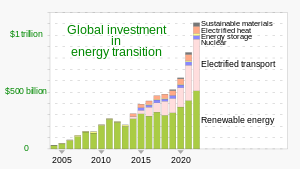
Back تجارة الطاقة المتجددة Arabic নবায়নযোগ্য শক্তি বাণিজ্যিকীকরণ Bengali/Bangla Comercialización de energías renovables Spanish تجاری سازی انرژیهای تجدید پذیر FA Komersialisasi energi terbarukan ID Comercialização de energia renovável Portuguese Renewable energy commercialization SIMPLE 可再生能源商业化 Chinese
This article has multiple issues. Please help improve it or discuss these issues on the talk page. (Learn how and when to remove these messages)
|


Levelized cost of energy (LCOE) is a measure of the average net present cost of electricity generation for a generating plant over its lifetime.
| Part of a series on |
| Sustainable energy |
|---|
 |
Renewable energy commercialization involves the deployment of three generations of renewable energy technologies dating back more than 100 years. First-generation technologies, which are already mature and economically competitive, include biomass, hydroelectricity, geothermal power and heat. Second-generation technologies are market-ready and are being deployed at the present time; they include solar heating, photovoltaics, wind power, solar thermal power stations, and modern forms of bioenergy. Third-generation technologies require continued R&D efforts in order to make large contributions on a global scale and include advanced biomass gasification, hot-dry-rock geothermal power, and ocean energy.[6] In 2019, nearly 75% of new installed electricity generation capacity used renewable energy[7] and the International Energy Agency (IEA) has predicted that by 2025, renewable capacity will meet 35% of global power generation.[8]
Public policy and political leadership helps to "level the playing field" and drive the wider acceptance of renewable energy technologies.[9][10][11] Countries such as Germany, Denmark, and Spain have led the way in implementing innovative policies which has driven most of the growth over the past decade. As of 2014, Germany has a commitment to the "Energiewende" transition to a sustainable energy economy, and Denmark has a commitment to 100% renewable energy by 2050. There are now 144 countries with renewable energy policy targets.
Renewable energy continued its rapid growth in 2015, providing multiple benefits. There was a new record set for installed wind and photovoltaic capacity (64GW and 57GW) and a new high of US$329 Billion for global renewables investment. A key benefit that this investment growth brings is a growth in jobs.[12] The top countries for investment in recent years were China, Germany, Spain, the United States, Italy, and Brazil.[10][13] Renewable energy companies include BrightSource Energy, First Solar, Gamesa, GE Energy, Goldwind, Sinovel, Targray, Trina Solar, Vestas, and Yingli.[14][15]
Climate change concerns[16][17][18] are also driving increasing growth in the renewable energy industries.[19][20] According to a 2011 projection by the IEA, solar power generators may produce most of the world's electricity within 50 years, reducing harmful greenhouse gas emissions.[21]
- ^ "Energy Transition Investment Hit $500 Billion in 2020 – For First Time". BloombergNEF. (Bloomberg New Energy Finance). 19 January 2021. Archived from the original on 19 January 2021.
- ^ Catsaros, Oktavia (26 January 2023). "Global Low-Carbon Energy Technology Investment Surges Past $1 Trillion for the First Time". Bloomberg NEF (New Energy Finance). Figure 1. Archived from the original on 22 May 2023.
Defying supply chain disruptions and macroeconomic headwinds, 2022 energy transition investment jumped 31% to draw level with fossil fuels
- ^ "Global Clean Energy Investment Jumps 17%, Hits $1.8 Trillion in 2023, According to BloombergNEF Report". BNEF.com. Bloomberg NEF. 30 January 2024. Archived from the original on 28 June 2024.
Start years differ by sector but all sectors are present from 2020 onwards.
- ^ Chrobak, Ula (28 January 2021). "Solar power got cheap. So why aren't we using it more?". Popular Science. Infographic by Sara Chodosh. Archived from the original on 29 January 2021. ● Chodosh's graphic is derived from data in "Lazard's Levelized Cost of Energy Version 14.0" (PDF). Lazard.com. Lazard. 19 October 2020. Archived (PDF) from the original on 28 January 2021.
- ^ "Lazard LCOE Levelized Cost Of Energy+" (PDF). Lazard. June 2024. p. 16. Archived (PDF) from the original on 28 August 2024.
- ^ International Energy Agency (2007). Renewables in global energy supply: An IEA facts sheet (PDF) OECD, 34 pages.
- ^ Carrington, Damian (6 April 2020). "New renewable energy capacity hit record levels in 2019". The Guardian. ISSN 0261-3077. Retrieved 22 October 2023.
- ^ Ellerbeck, Stefan (16 March 2023). "IEA: More than a third of the world's electricity will come from renewables in 2025". World Economic Forum. Retrieved 22 October 2023.
- ^ Donald W. Aitken. Transitioning to a Renewable Energy Future, International Solar Energy Society, January 2010, p. 3.
- ^ a b REN21 (2012). Renewables Global Status Report 2012 Archived 15 December 2012 at the Wayback Machine p. 17.
- ^ REN21 (2011). "Renewables 2011: Global Status Report" (PDF). pp. 11–13. Archived from the original (PDF) on 5 September 2011.
{{cite web}}: CS1 maint: numeric names: authors list (link) - ^ Editorial, Green Gold, Nature Energy, 2016.
- ^ REN21 (2011). "Renewables 2011: Global Status Report" (PDF). p. 35. Archived from the original (PDF) on 5 September 2011.
{{cite web}}: CS1 maint: numeric names: authors list (link) - ^ Top of the list, Renewable Energy World, 2 January 2006.
- ^ Keith Johnson, Wind Shear: GE Wins, Vestas Loses in Wind-Power Market Race, Wall Street Journal, 25 March 2009, accessed on 7 January 2010.
- ^ International Energy Agency. IEA urges governments to adopt effective policies based on key design principles to accelerate the exploitation of the large potential for renewable energy 29 September 2008.
- ^ REN21 (2006). Changing climates: The Role of Renewable Energy in a Carbon-constrained World (PDF) Archived 11 June 2007 at the Wayback Machine p. 2.
- ^ HM Treasury (2006). Stern Review on the Economics of Climate Change.
- ^ New UN report points to power of renewable energy to mitigate carbon emissions UN News Centre, 8 December 2007.
- ^ Joel Makower, Ron Pernick and Clint Wilder (2008). Clean Energy Trends 2008 Archived 10 July 2018 at the Wayback Machine, Clean Edge, p. 2.
- ^ Ben Sills (29 August 2011). "Solar May Produce Most of World's Power by 2060, IEA Says". Bloomberg.